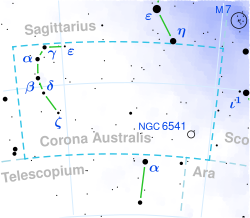Astronomy:HD 175219
| Observation data Epoch J2000.0 Equinox (celestial coordinates) | |
|---|---|
| Constellation | Corona Australis |
| Right ascension | 18h 56m 16.95125s[1] |
| Declination | −42° 42′ 38.4231″[1] |
| Apparent magnitude (V) | 5.35±0.01[2] |
| Characteristics | |
| Spectral type | K0 III[3] or G6 III-IV[4] |
| B−V color index | +1.00[5] |
| Astrometry | |
| Radial velocity (Rv) | −21.1±0.8[6] km/s |
| Proper motion (μ) | RA: −27.046 mas/yr Dec.: −29.284 mas/yr |
| Parallax (π) | 10.3847 ± 0.109[1] mas |
| Distance | 314 ± 3 ly (96 ± 1 pc) |
| Absolute magnitude (MV) | +0.57[7] |
| Details | |
| Mass | 1.93±0.21[8] M☉ |
| Radius | 12.3±0.2[8] R☉ |
| Luminosity | 76.3±2.0[8] L☉ |
| Surface gravity (log g) | 2.55±0.07[8] cgs |
| Temperature | 4,877±26[8] K |
| Metallicity [Fe/H] | −0.28±0.02[8] dex |
| Rotational velocity (v sin i) | <1[9] km/s |
| Age | 346[1] Myr |
| Other designations | |
| Database references | |
| SIMBAD | data |
HD 175219, also known as HR 7122, is a solitary,[11] orange hued star located in the southern constellation Corona Australis. It has an apparent magnitude of 5.35,[2] allowing it to be faintly visible to the naked eye. The object is located relatively close at a distance of 314 light years based on Gaia DR3 parallax measurements[1] but is drifting closer with a heliocentric radial velocity of −21.1 km/s.[6] At its current distance, HD 175219's brightness is diminished by 0.26 magnitudes due to interstellar dust.[12] It has an absolute magnitude of +0.57.[7]
This is a red giant with a stellar classification of K0 III.[3] An earlier source gives it a class of G6 III-IV,[4] indicating that it is an evolved G-type star with a luminosity class intermediate between a giant star and a subgiant. At present it has nearly twice the mass of the Sun but it has expanded to 12.3 times the Sun's radius.[8] HD 175219 radiates 76.3 times the luminosity of the Sun from its enlarged photosphere at an effective temperature of 4,877 K.[8] The star is metal deficient, having less than half the abundance of heavy elements compared to the Sun.[8] Common for giant stars, it spins slowly, having a projected rotational velocity too low to be measured accurately.[9]
References
- ↑ 1.0 1.1 1.2 1.3 1.4 Vallenari, A. et al. (2022). "Gaia Data Release 3. Summary of the content and survey properties". Astronomy & Astrophysics. doi:10.1051/0004-6361/202243940 Gaia DR3 record for this source at VizieR.
- ↑ 2.0 2.1 Høg, E.; Fabricius, C.; Makarov, V. V.; Urban, S.; Corbin, T.; Wycoff, G.; Bastian, U.; Schwekendiek, P. et al. (March 2000). "The Tycho-2 catalogue of the 2.5 million brightest stars". Astronomy and Astrophysics 355: L27–L30. ISSN 0004-6361. Bibcode: 2000A&A...355L..27H.
- ↑ 3.0 3.1 Houk, Nancy (1978). Michigan catalogue of two-dimensional spectral types for the HD stars Volume II: Declinations −52° to −41°. Bibcode: 1978mcts.book.....H.
- ↑ 4.0 4.1 Evans, D. S.; Menzies, A.; Stoy, R. H. (1 December 1959). "Fundamental Data for Southern Stars (Second List)". Monthly Notices of the Royal Astronomical Society 119 (6): 638–647. doi:10.1093/mnras/119.6.638. ISSN 0035-8711. Bibcode: 1959MNRAS.119..638E.
- ↑ Johnson, H. L.; Mitchell, R. I.; Iriarte, B.; Wisniewski, W. Z. (1966). "UBVRIJKL Photometry of the Bright Stars". Communications of the Lunar and Planetary Laboratory 4: 99–110. Bibcode: 1966CoLPL...4...99J.
- ↑ 6.0 6.1 Gontcharov, G. A. (November 2006). "Pulkovo Compilation of Radial Velocities for 35 495 Hipparcos stars in a common system". Astronomy Letters 32 (11): 759–771. doi:10.1134/S1063773706110065. ISSN 1063-7737. Bibcode: 2006AstL...32..759G.
- ↑ 7.0 7.1 Anderson, E.; Francis, Ch. (May 2012). "XHIP: An extended hipparcos compilation". Astronomy Letters 38 (5): 331–346. doi:10.1134/S1063773712050015. ISSN 1063-7737. Bibcode: 2012AstL...38..331A.
- ↑ 8.0 8.1 8.2 8.3 8.4 8.5 8.6 8.7 8.8 Ottoni, G.; Udry, S.; Ségransan, D.; Buldgen, G.; Lovis, C.; Eggenberger, P.; Pezzotti, C.; Adibekyan, V. et al. (January 2022). "CORALIE radial-velocity search for companions around evolved stars (CASCADES): I. Sample definition and first results: Three new planets orbiting giant stars". Astronomy & Astrophysics 657: A87. doi:10.1051/0004-6361/202040078. ISSN 0004-6361. Bibcode: 2022A&A...657A..87O.
- ↑ 9.0 9.1 De Medeiros, J. R.; Alves, S.; Udry, S.; Andersen, J.; Nordström, B.; Mayor, M. (January 2014). "A catalog of rotational and radial velocities for evolved stars". Astronomy & Astrophysics 561: A126. doi:10.1051/0004-6361/201220762. ISSN 0004-6361. Bibcode: 2014A&A...561A.126D.
- ↑ "HD 175219". SIMBAD. Centre de données astronomiques de Strasbourg. http://simbad.u-strasbg.fr/simbad/sim-basic?Ident=HD+175219.
- ↑ Eggleton, P. P.; Tokovinin, A. A. (11 September 2008). "A catalogue of multiplicity among bright stellar systems". Monthly Notices of the Royal Astronomical Society 389 (2): 869–879. doi:10.1111/j.1365-2966.2008.13596.x. ISSN 0035-8711. Bibcode: 2008MNRAS.389..869E.
- ↑ Gontcharov, George A.; Mosenkov, Aleksandr V. (28 September 2017). "Verifying reddening and extinction for Gaia DR1 TGAS main sequence stars". Monthly Notices of the Royal Astronomical Society 472 (4): 3805–3820. doi:10.1093/mnras/stx2219. ISSN 0035-8711. Bibcode: 2017MNRAS.472.3805G.
<ref> tag with name "Gould1879" defined in <references> is not used in prior text.
 |


